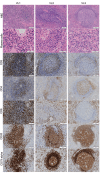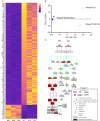An integrated analysis of the structural changes and gene expression of spleen in human visceral leishmaniasis with and without HIV coinfection
- PMID: 38843306
- PMCID: PMC11265696
- DOI: 10.1371/journal.pntd.0011877
An integrated analysis of the structural changes and gene expression of spleen in human visceral leishmaniasis with and without HIV coinfection
Abstract
The spleen plays a pivotal role in the pathogenesis of visceral leishmaniasis. In severe forms of the disease, the spleen undergoes changes that can compromise its function in surveilling blood-circulating pathogens. In this study, we present an integrated analysis of the structural and gene expression alterations in the spleens of three patients with relapsing visceral leishmaniasis, two of whom were coinfected with HIV. Our findings reveal that the IL6 signaling pathway plays a significant role in the disorganization of the white pulp, while BCL10 and ICOSLG are associated with spleen organization. Patients coinfected with HIV and visceral leishmaniasis exhibited lower splenic CD4+ cell density and reduced expression of genes such as IL15. These effects may contribute to a compromised immune response against L. infantum in coinfected individuals, further impacting the structural organization of the spleen.
Copyright: © 2024 Fontes et al. This is an open access article distributed under the terms of the Creative Commons Attribution License, which permits unrestricted use, distribution, and reproduction in any medium, provided the original author and source are credited.
Conflict of interest statement
The authors have declared that no competing interests exist.
Figures


Similar articles
-
Histological Disorganization of Spleen Compartments and Severe Visceral Leishmaniasis.Front Cell Infect Microbiol. 2018 Nov 13;8:394. doi: 10.3389/fcimb.2018.00394. eCollection 2018. Front Cell Infect Microbiol. 2018. PMID: 30483481 Free PMC article. Review.
-
Low CXCL13 expression, splenic lymphoid tissue atrophy and germinal center disruption in severe canine visceral leishmaniasis.PLoS One. 2012;7(1):e29103. doi: 10.1371/journal.pone.0029103. Epub 2012 Jan 5. PLoS One. 2012. PMID: 22242159 Free PMC article.
-
Morphophysiological changes in the splenic extracellular matrix of Leishmania infantum-naturally infected dogs is associated with alterations in lymphoid niches and the CD4+ T cell frequency in spleens.PLoS Negl Trop Dis. 2018 Apr 20;12(4):e0006445. doi: 10.1371/journal.pntd.0006445. eCollection 2018 Apr. PLoS Negl Trop Dis. 2018. Retraction in: PLoS Negl Trop Dis. 2022 Feb 16;16(2):e0010225. doi: 10.1371/journal.pntd.0010225. PMID: 29677186 Free PMC article. Retracted.
-
Multilocus microsatellite typing of Leishmania infantum isolates in monitored Leishmania/HIV coinfected patients.Parasit Vectors. 2015 Jul 22;8:386. doi: 10.1186/s13071-015-0989-9. Parasit Vectors. 2015. PMID: 26198004 Free PMC article.
-
Leishmania and human immunodeficiency virus coinfection: the first 10 years.Clin Microbiol Rev. 1997 Apr;10(2):298-319. doi: 10.1128/CMR.10.2.298. Clin Microbiol Rev. 1997. PMID: 9105756 Free PMC article. Review.
Cited by
-
Insights to the HIV-associated visceral leishmaniasis clinical outcome: lessons learned about immune mediated disorders.Front Immunol. 2025 Mar 12;16:1516176. doi: 10.3389/fimmu.2025.1516176. eCollection 2025. Front Immunol. 2025. PMID: 40145085 Free PMC article. Review.
References
-
- Saporito L, Giammanco GM, De Grazia S, Colomba C. Visceral leishmaniasis: host–parasite interactions and clinical presentation in the immunocompetent and in the immunocompromised host. International Journal of Infectious Diseases. 2013. Aug;17(8):e572–6. doi: 10.1016/j.ijid.2012.12.024 - DOI - PubMed
MeSH terms
LinkOut - more resources
Full Text Sources
Medical
Research Materials
Miscellaneous

